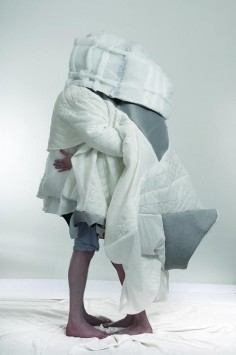Danica Pišteková
The Sewn as a Site
source: highlike
Work: This dress/house objects blurs the classic definitions of architecture (‘firmitas, utilitas, venustas’) to reveal the hidden ones. If, as Zevi says, architecture is an object where I am able to come in, my clothing-house does that. If, as Rossi says, architecture is theatre for life, my soft house offers conditions for different situations by constantly changing the clothes and location in one system. And if architecture is only the system of transits and boundaries, this process also provides them. For Tschumi, architecture is an event, a turning point, a place of shock. The clothing-house is also trying to surprise by paradoxical behaviour, discovering in-between spaces or moments where the boundary between interior and exterior is changing with every movement. The result is architecture as an intellectual and sensual experience. It was created by an architect with the hands of a tailor and wants to remind us that architecture is the way of thinking standing before any built reality.
Danica Pišteková graduated from The Academy of Fine Arts and Design, Department of Architecture in Bratislava, Slovakia, in 2012 (master of art degree). She was awarded The Rector Award for the best diploma thesis. She continues her postgraduate studies in the field of architecture, where she tries to find a specific relations between architecture and fashion.
Photographer: Matej Kukučka
.
.
.
.
.
.
.
source: tdwa
この着ることができるキルトの繭とブランケットはスロバキアの建築学校を卒業したDanica Pistekovaによるものです。朝になってもベッドを身に付けたい人にとってはぴったりです。Pistekovaは布地と羽布団を入り込ませて縫い付け、服と住まいの中間を求める2人に持ち運びできる空間を作るため、調整できる構造にしました。「このプロジェクトの間にあるものは」PistekovaはDezeenに対してこのように言いました。「ファッションと建築、大と小、私的なものと公共のもの、直感的なものと論理的なものです。」「私にとって、服はもう一つの建築の様式なのです。」と彼女は付け加えました。Pistekovaは今年、ブラチスラバにあるUniversity of Fine Arts and Designの建築学を卒業しました。
Dezeenでは最近、もう一つの建築学卒業生が作成した折りたたんだ紙のドレスのコレクションを特集しました。記事はこちらをご覧ください。私の卒業論文の実務箇所の結果としては、服と住宅のセットです。これらのものは信頼性、安全性、審美性という建築の昔ながらの定義をあいまいにし、隠されているものを明らかにします。ゼーヴィは「建築というのは私が室内着で入ることができるものである」と述べ、ロッシは「建築は人生の劇場なのです。私の柔らかい家は常に服装と場所を一つのシステムで変えることによって、異なった状況のためのコンディションを提供します」と述べています。そしてもし建築が移動と境界の単なるシステムであるのなら、この過程はまた同じものを提供するのです。チュミにとって建築というのは出来事であり、分岐点であり、衝撃的な場所なのです。この室内着はまた、逆説的な行動と、内面と外面の境界にある場所に空間や時間が常に変化していることを発見することにより驚かせることを試みようとしています。結果として知的、感覚的な経験としての建築であり、私は仕立て屋の手で建築を作り、建築が目の前に建っている建物の考え方を思い出してもらいたいのです。
.
.
.
.
.
.
.
source: dezeen
This wearable cocoon of quilts and blankets by Slovakian architecture graduate Danica Pistekova is just right for people who wish they could take their bed with them in the morning. Pistekova sewed fabric and duvets into a complex, adjustable structure to create a portable environment for two people that’s meant to be halfway between clothing and housing.
“The project is something in between,” Pistekova told Dezeen. “Between fashion and architecture, small and big, private and public, intuitive and logical.”For me, dress is only another state of architecture,” she added. Pistekova graduated from architecture at the University of Fine Arts and Design in Bratislava this year. We recently featured a collection of folded paper dresses made by another architecture graduate.
The result of the practical part of my diploma thesis is a set of dresses/houses. These objects blur the classic definitions of architecture (‘firmitas, utilitas, venustas’) to reveal the hidden ones.
If, as Zevi says, architecture is an object where I am able to come in, my clothing-house does that. If, as Rossi says, architecture is theatre for life, my soft house offers conditions for different situations by constantly changing the clothes and location in one system. And if architecture is only the system of transits and boundaries, this process also provides them. For Tschumi, architecture is an event, a turning point, a place of shock. The clothing-house is also trying to surprise by paradoxical behaviour, discovering in-between spaces or moments where the boundary between interior and exterior is changing with every movement.The result is architecture as an intellectual and sensual experience. It was created by an architect with the hands of a tailor and wants to remind us that architecture is the way of thinking standing before any built reality.


